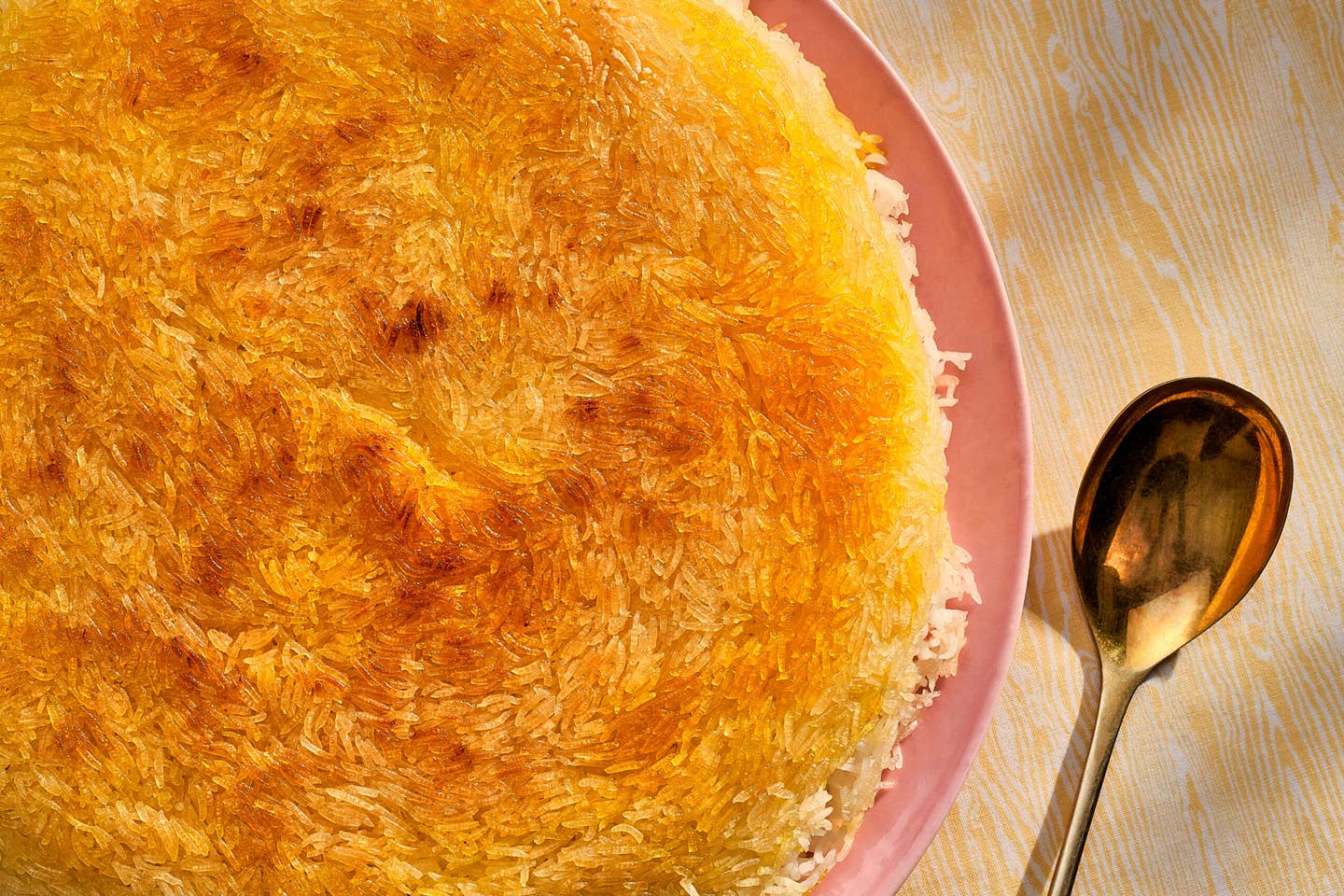Chelo ba Tahdig (Steamed Saffron Rice with Tahdig)
Saffron-stained grains with a golden, toothsome outer layer.
- Serves
serves 6
- Time
2 hours 10 minutes

Cookbook author Naz Deravian's chelo ba tahdig recipe calls for the traditional two-step method of Persian rice preparation—parboil, then add just enough fat to the bottom of the pot to turn out (fingers crossed) a crispy, crunchy tahdig. The result is long, individual, saffron-stained grains of rice with a golden, toothsome outer layer. Be sure to have your clarified butter prepared before you begin, and use a flat-bottomed, straight-sided, lightweight nonstick pot.
What You Will Need
Ingredients
- 3 cups (1 lb. 4 oz.) extra-long white basmati rice
- 1⁄4 cup plus 2 Tbsp. kosher salt, divided
- 1⁄4 tsp. saffron, lightly ground between your fingers
- 1⁄4 cup clarified unsalted butter, divided
- 1 tbsp. extra-virgin olive oil, plus more as needed
Instructions
Step 1
Step 2
Step 3
Step 4
Step 5
Step 6
Step 7
- In a large bowl, add the rice and enough water to cover by several inches. Gently swish the rice around, then drain. Repeat until the water runs clear, about 5 rinses, then drain completely. Return the rice to the bowl. Cover the rice with 2 cups fresh cold water, add 2 tablespoons kosher salt, and stir gently to dissolve. Let the rice soak at room temperature for 1 hour.
- In a 10-inch, flat-bottomed, nonstick pot, bring 12 cups of water to boil over high heat. Add ¼ cup kosher salt and stir to dissolve. Drain the rice (don’t rinse it), and add it to the pot. Stir once gently, and don’t go anywhere (the water can boil over very easily). Spoon away and discard any foam that rises to the top. As soon as you see the first grain of rice pop up, set a timer for 4 minutes and place a large, fine-mesh strainer in the sink. Start taste-testing the rice at 4 minutes. When the grains are tender on the outside with a little bite on the inside, 5–7 minutes, drain and quickly rinse with lukewarm tap water. (Use the spray option on your faucet if you have one; if not, place your hand under the tap and create a spray with your fingers.) Wash and dry the pot and return it to the stove.
- Bring a small amount of water to boil; remove and let rest for 5 minutes. In a small heatproof bowl, add the saffron and ¼ cup of the hot water. Set aside.
- Place the colander of drained rice by the stove. Set the rice pot over medium heat and add 2 tablespoons of the clarified butter, the olive oil, and 1 tablespoon of the saffron water. Cook until the butter is melted, then lift the pot and swirl the fats around so they evenly cover the bottom of the pot and a little up the sides, adding another tablespoon or two of oil as needed to coat the bottom in a very thin layer. Work quickly now: As soon as the oil starts to sizzle, immediately add enough rice to fully cover the bottom of the pot in a thin layer (about 3 cups). Pack the rice down with a spatula (this will become your tahdig layer). Gently scatter the remaining rice over the tahdig, mounding it slightly in the center and making sure that the entire tahdig layer is covered with more rice. With the handle of the spatula, poke a few holes in the rice without hitting the tahdig layer, to allow steam to escape. Turn the heat up to medium-high, cover the pot, and cook for 10–12 minutes to allow the tahdig to set.
- Meanwhile, in a small pot, gently melt the remaining 2 tablespoons of clarified butter. Add the remaining saffron water, and keep warm.
- When the 10–12 minutes are up, lift the rice pot lid, taking care not to drip the condensation trapped under the lid back into the rice, then drizzle the butter mixture over the rice. Wrap the lid in a kitchen towel or a couple of layers of paper towels to catch the condensation. (Make sure the kitchen towel or paper towels are secured on top so they don’t catch fire.) Return the lid to the pot, adjust the heat to medium, and cook until steam begins to escape from the edges of the lid, about 10 minutes. Lower the heat to medium-low and continue cooking, rotating the pot a few times for even crisping, until the rice is tender and fluffy and the tahdig is crispy and golden, 30–40 minutes. (It’s tricky to check for doneness, but look for the rice on the sides of the pot to appear dry and set.)
- To help release the tahdig, fill the sink with about 1 inch of cold water, and dip the bottom of the rice pot in the water quickly. (Alternatively, wet a kitchen towel and set the pot atop the wet towel.) To serve, you can scatter the rice across a platter and serve the tahdig whole or in pieces on the side. Or, place an appropriately sized flat plate or platter over the pot, take a deep breath, and quickly and confidently flip the pot over. You should hear a swish when the tahdig releases. Remove the pot, and serve immediately.
Keep Reading
Continue to Next Story










